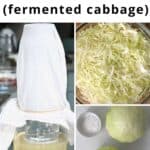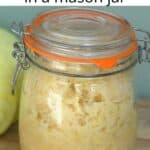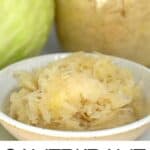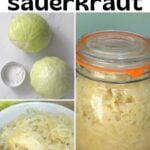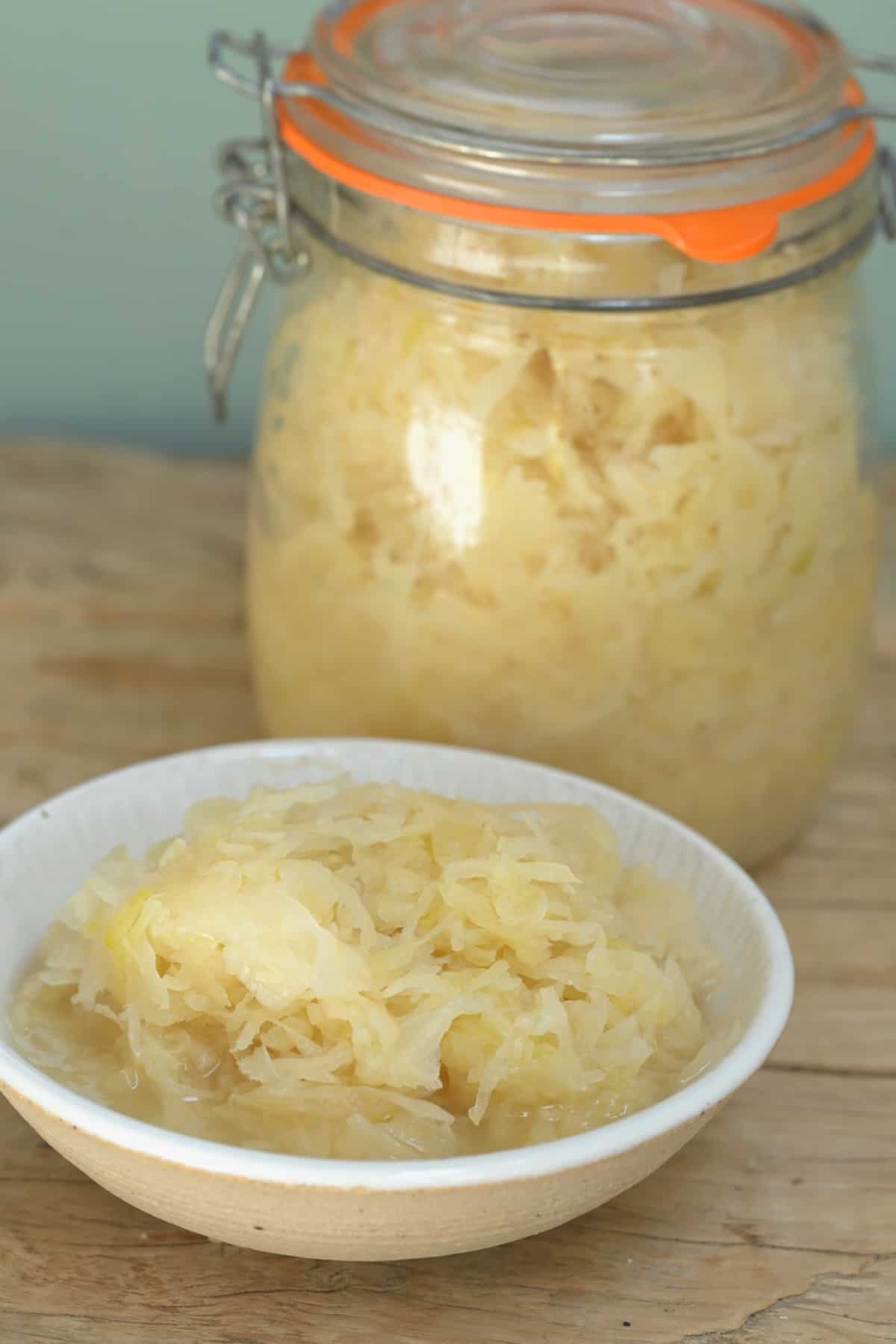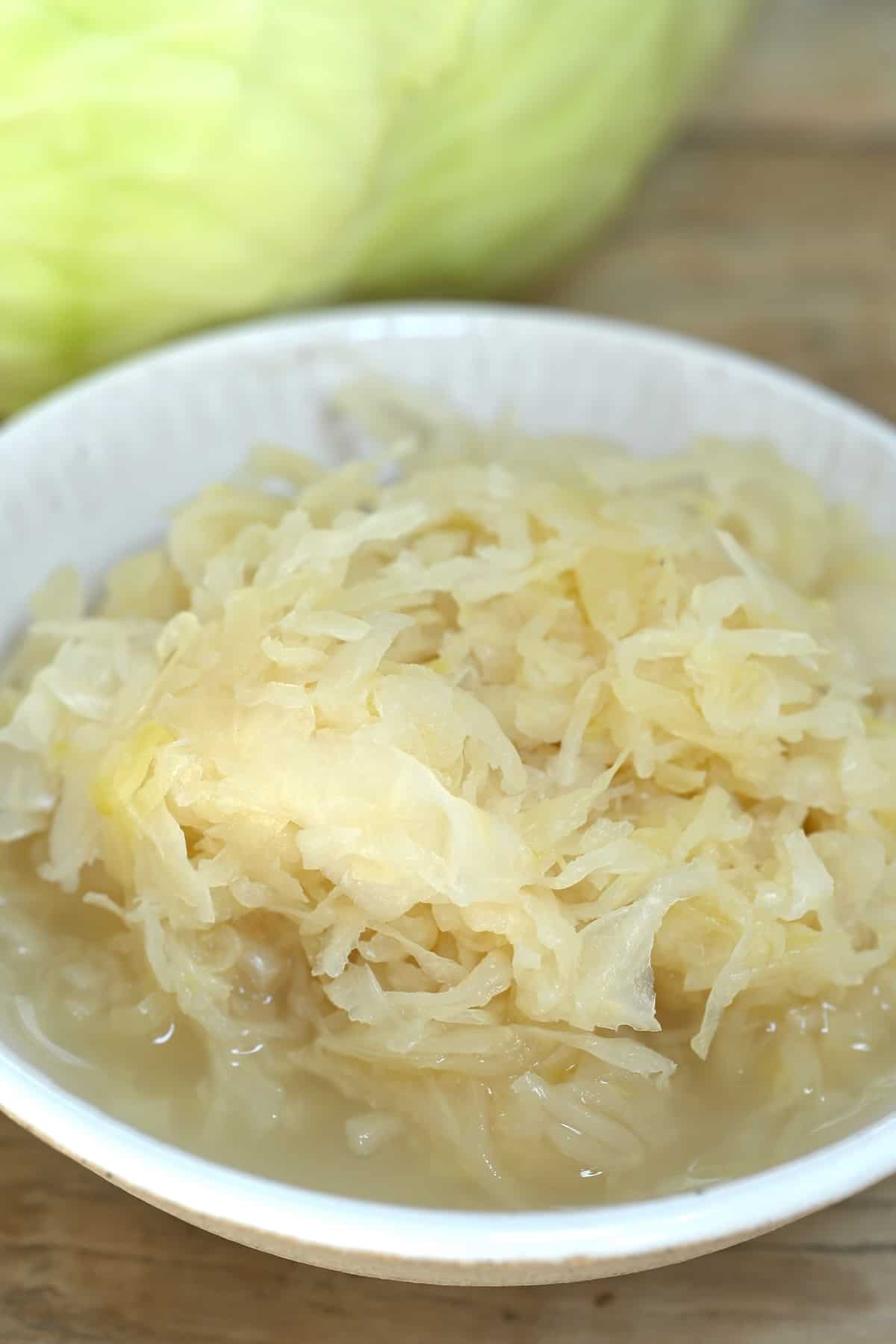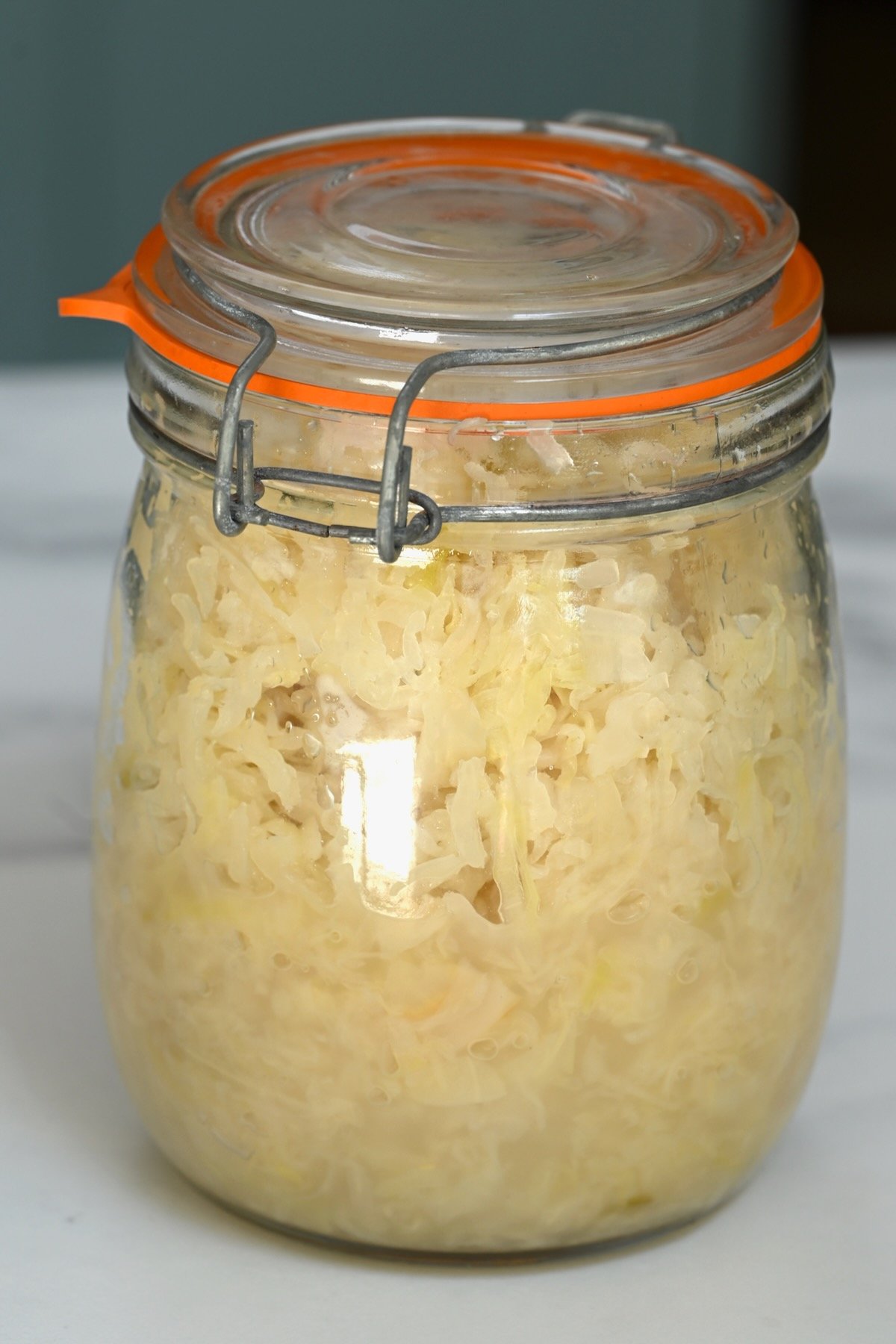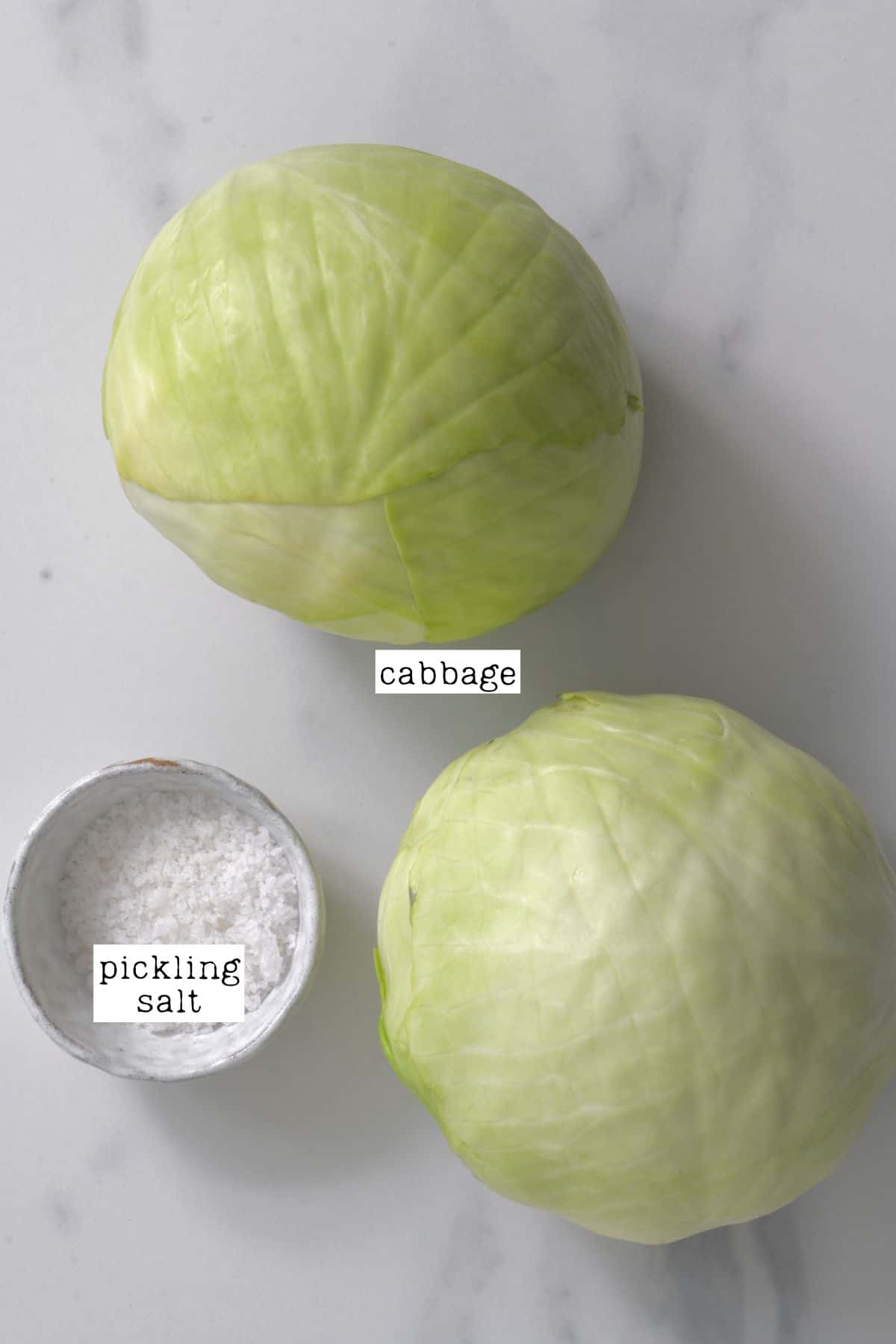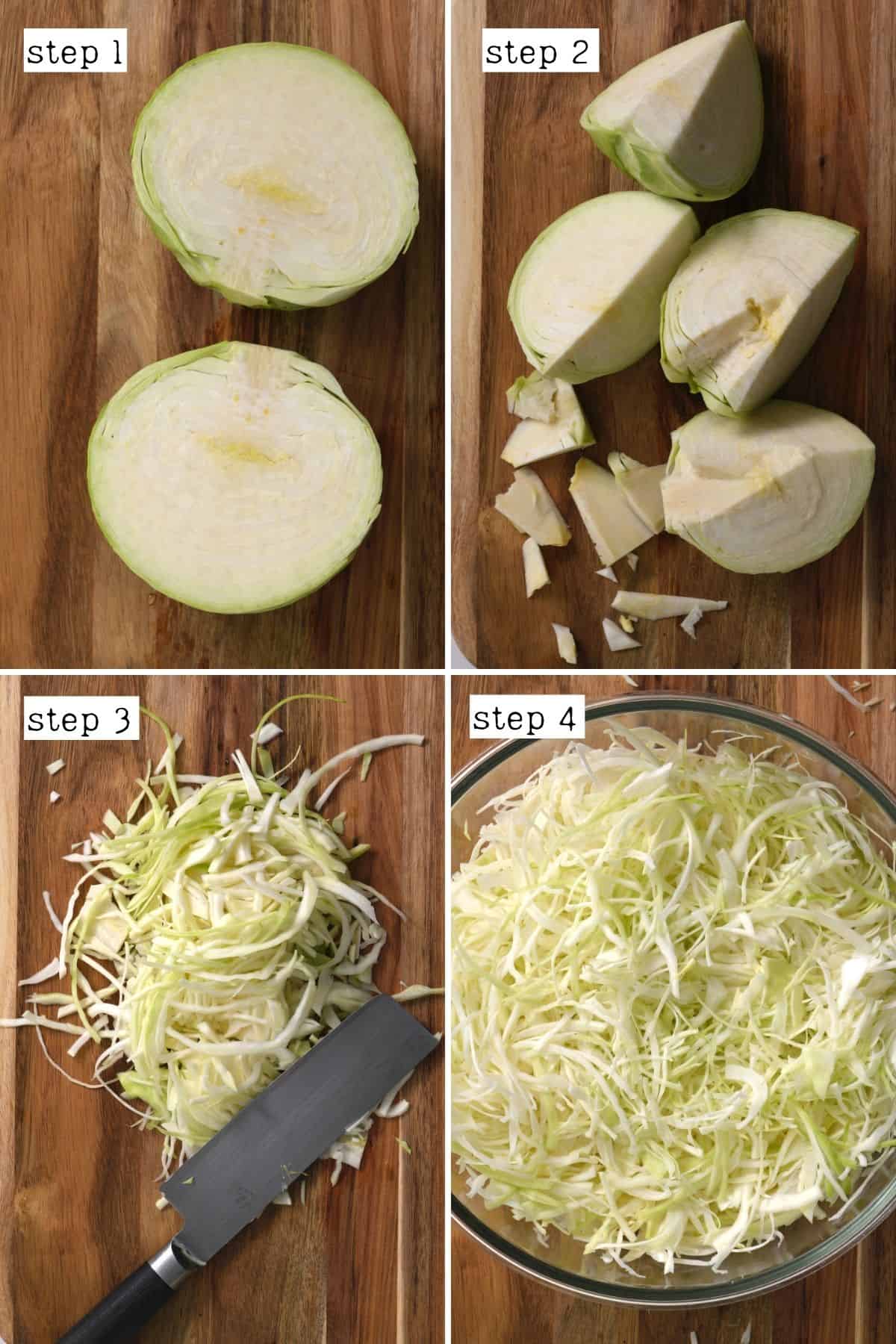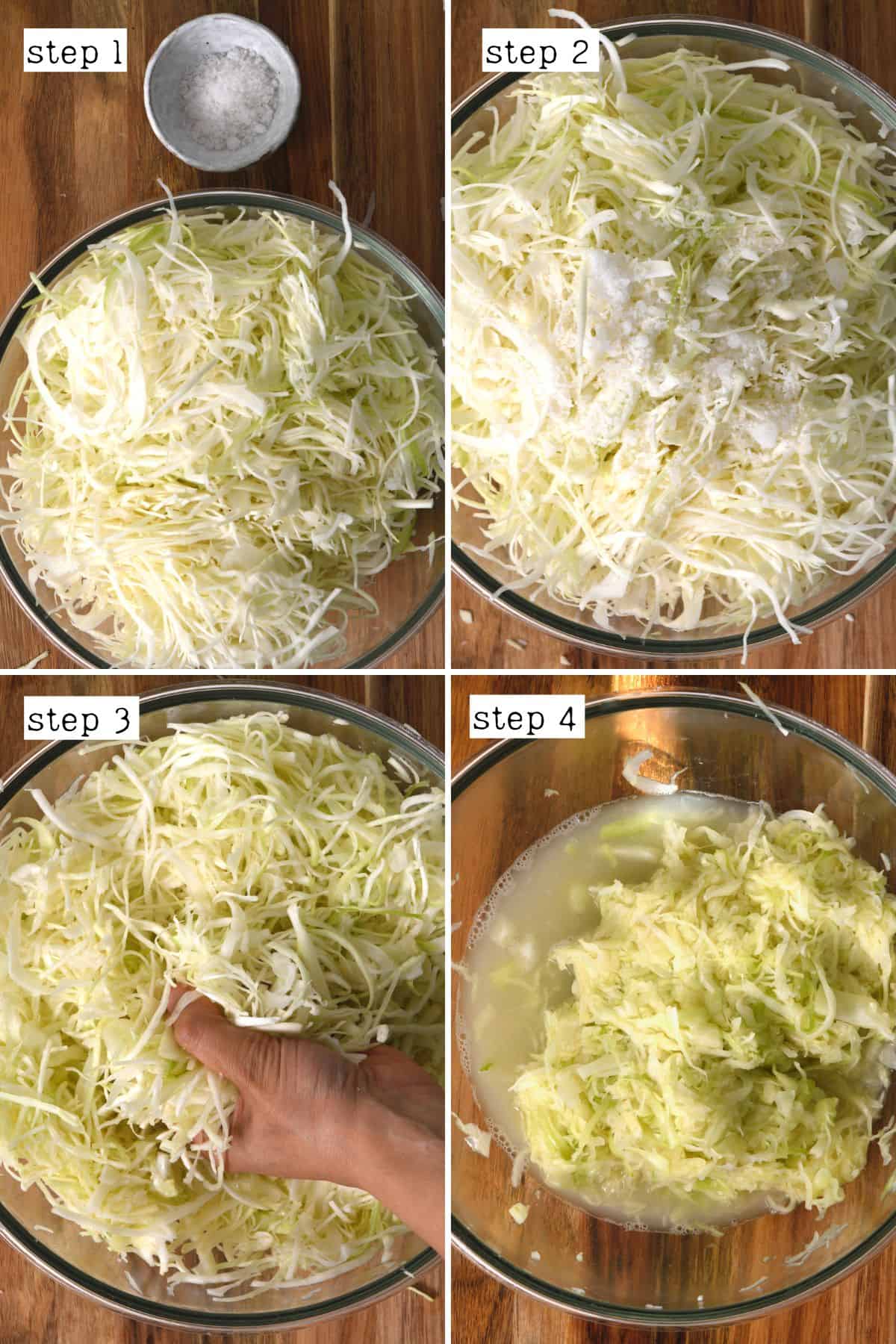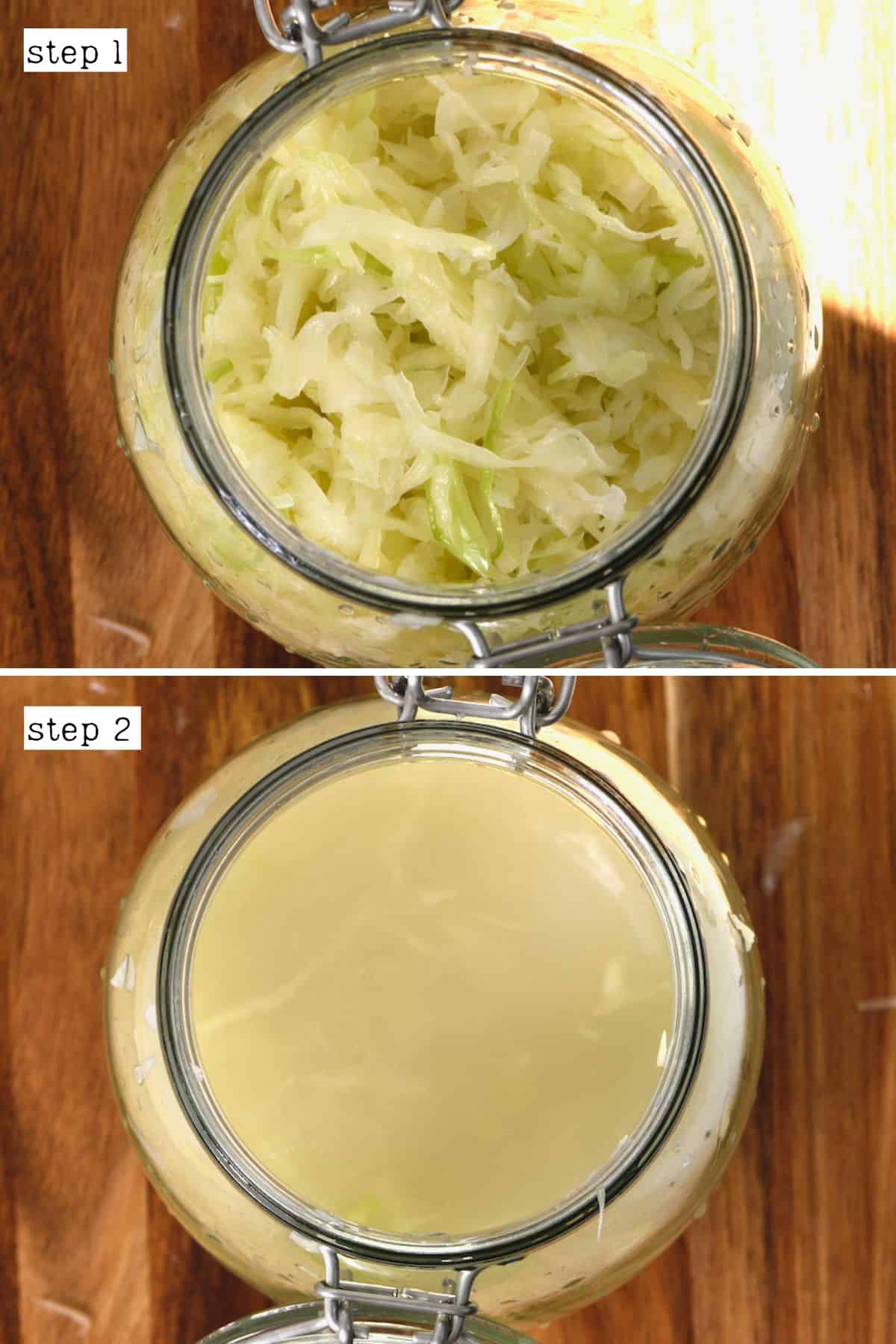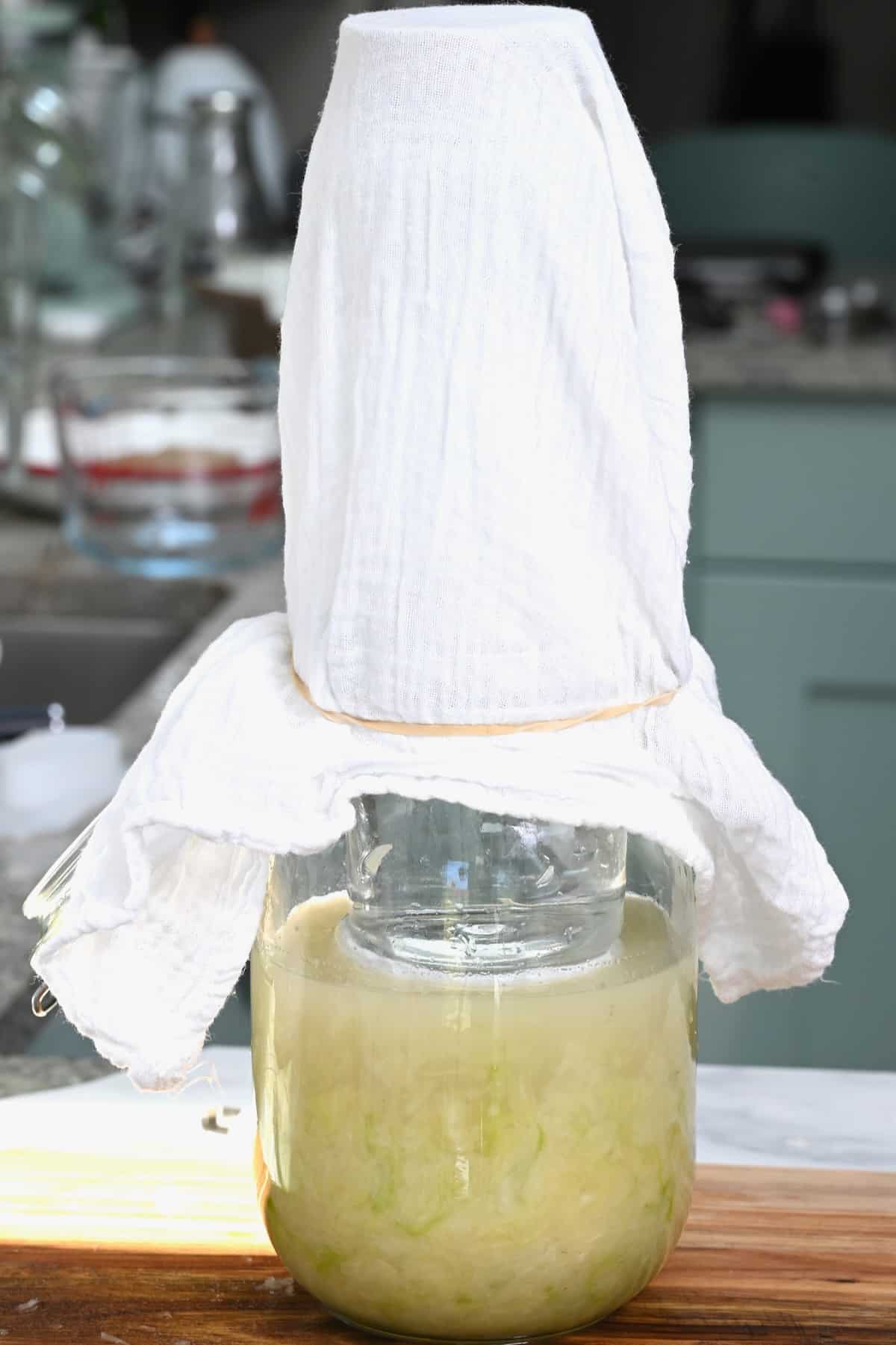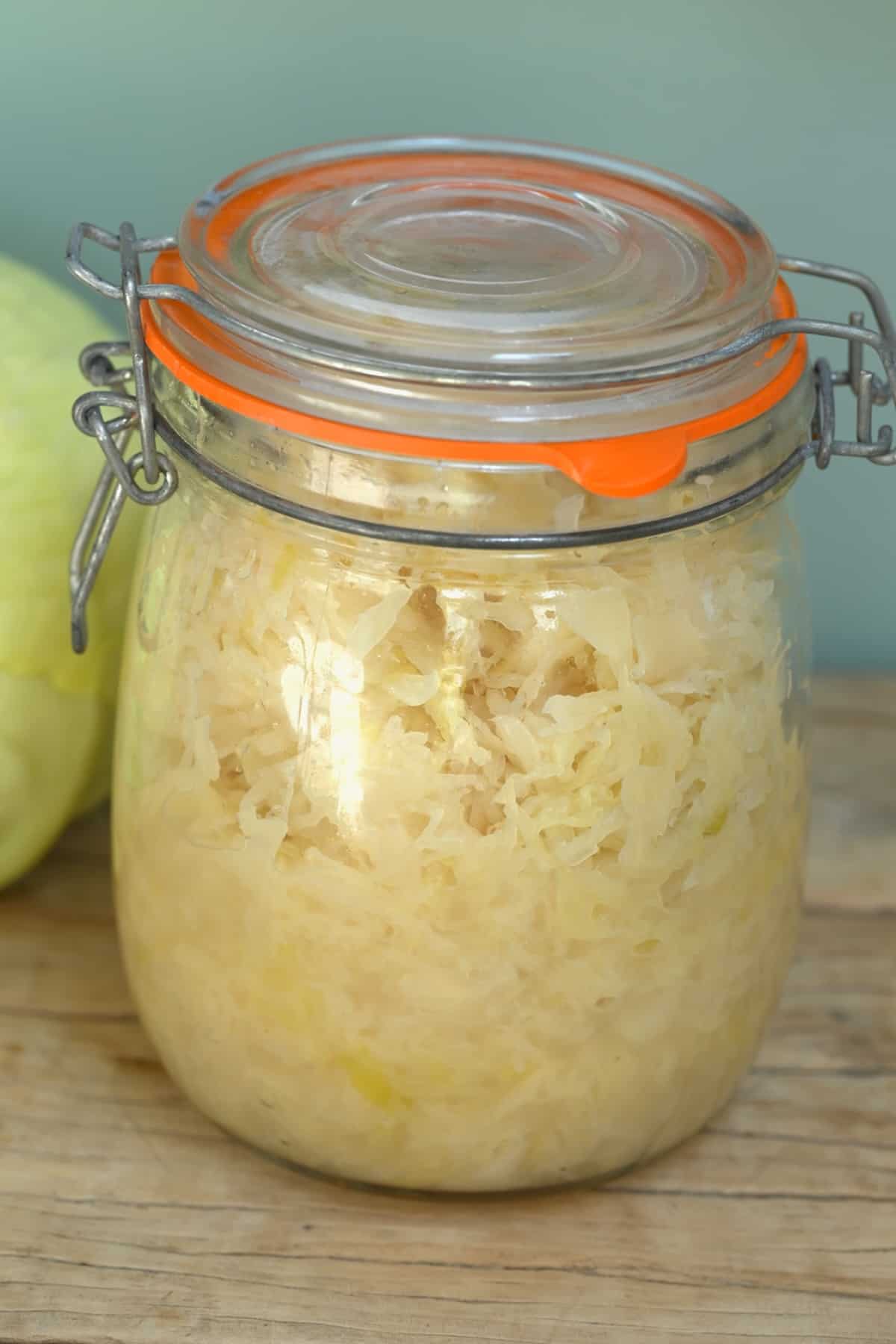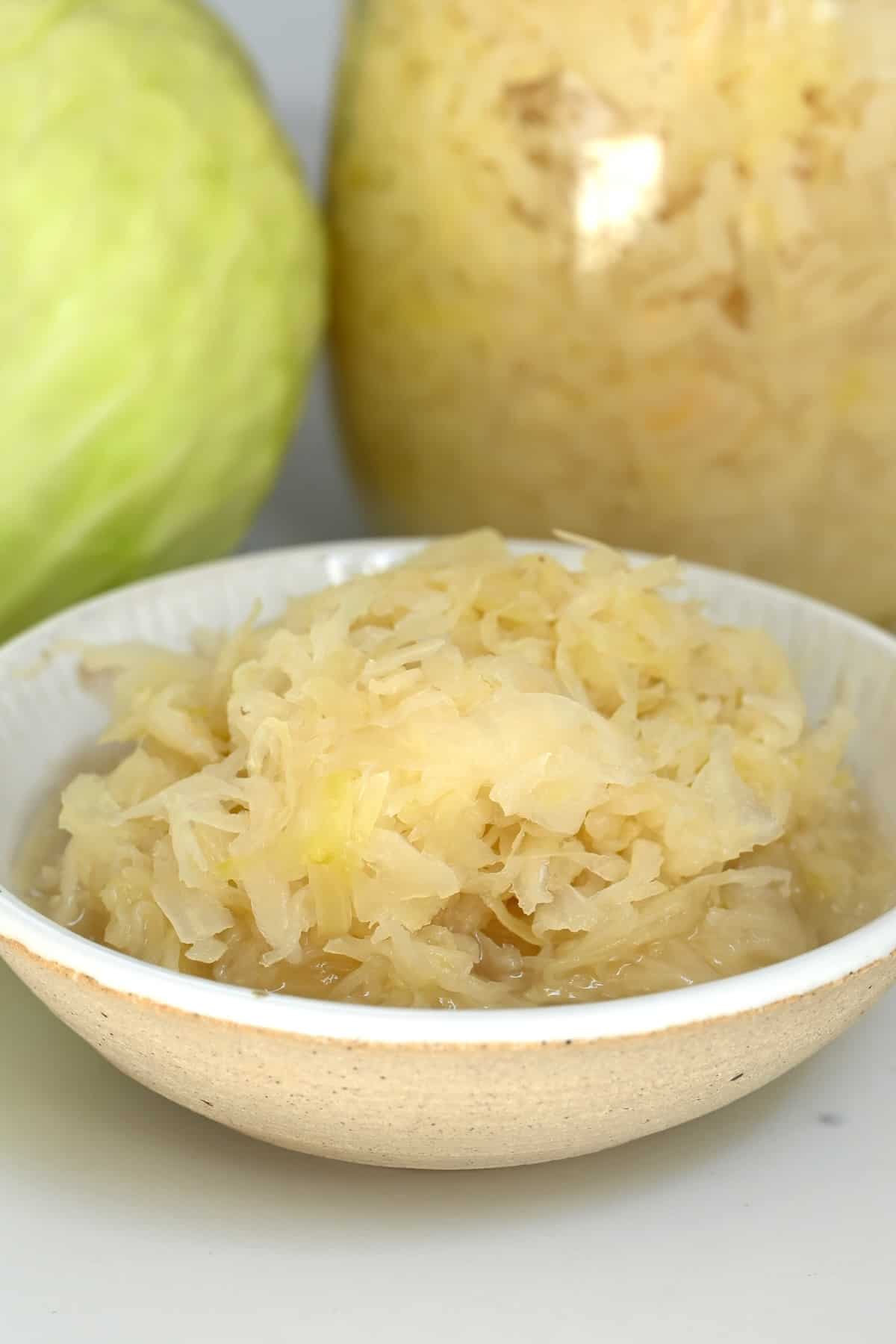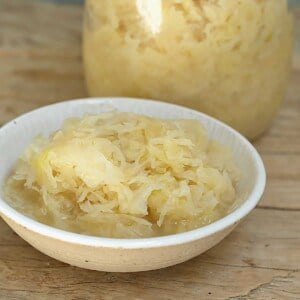Over the past couple of years, I’ve placed more importance on consuming probiotic-rich fermented foods like yogurt, fermented garlic honey, kombucha, and this homemade sauerkraut recipe to keep my gut and body healthy and thriving. Luckily, making sauerkraut is inexpensive and simple enough for even fermentation beginners!
What Is Sauerkraut
Sauerkraut (often misspelled as saurkraut or sourkraut), meaning “sour cabbage,” is a fermented cabbage dish native to Germany (and popular across Europe), though some say it originated in China. With few ingredients, the process ferments raw cabbage with lactic acid bacteria that forms from the sugars within the cabbage leaves. The resulting dish is sour, crunchy, and – like most fermented/pickled items – has a long shelf life. The process is super simple too. All you need is just TWO base ingredients (several regional varieties/optional add-ins included below) and around 10 minutes of hands-on prep time to prepare this homemade sauer kraut recipe. Leave it to ferment and voila. Want to try more simple pickled recipes? You might enjoy these pink pickled red onions, quick pickled asparagus, or pickled garlic (regular or spicy)!
Is Sauerkraut Good for You
Unlike kimchi, a Korean fermented cabbage dish, which tastes salty and spicy and often combines several fermented ingredients into the pickling “liquid,” sauerkraut is very simple, with minimal ingredients and a sour, acidic flavor. While there are fewer probiotics, it’s still highly nutritious and beneficial. The process of fermentation actually increases the bioavailability of several nutrients in the cabbage (including Vitamins C – great for immune health – and K – which is good for bone health), making it MORE nutritious than initially. However, cabbage is also an excellent source of magnesium and calcium and contains iron, potassium, copper, manganese, and folate. Not to mention the fiber, too. Due to the fermentation process, this homemade sauerkraut also contains probiotics in the form of living, gut-healthy bacteria. They promote gut and digestive health, boost your immune system with anti-inflammatory benefits, and even detoxify your body. There are also links between gut health and mental health/brain health. Please refer to Healthline for more information on sauerkraut benefits. Just note that over-consumption may cause bloating and gas.
What Is Sauerkraut Made of
The base sauerkraut recipes require just TWO ingredients.
Cabbage: I recommend using organic (when possible) green cabbage to make this easy sauerkraut recipe.
Pickling salt: Pickling salt is best, but otherwise, any iodine-free salt will work.
You will also need glass mason jars or canning jars and a glass weight (or pickling weight, or inverted plate). While most cabbages will ferment, round-headed green cabbage is the most common type for sauerkraut as it ferments easily, maintains its crunch, and generally produces the best sauerkraut. You could also experiment with fermented red cabbage (which will have a more robust flavor) or napa cabbage (which has a milder flavor and will produce softer fermented sauerkraut). When selecting the cabbage, make sure it’s firm, compact, and heavy for its size with bright, crisp leaves. It should also be slightly sweet (avoid bitter cabbage). The fresher it is, the better, too, as it will naturally create more brine and contains more beneficial bacteria.
How to Make Sauerkraut
First, sterilize the jar/s you plan to store the sauerkraut in. Jars with an airlock lid are useful for fermentation, but not necessary. Alternatively, you can make the homemade kraut in a traditional crock. To do so, preheat the oven to 325ºF/160ºC. Meanwhile, wash the jars and lids in hot, soapy water and rinse them after. Then, transfer them to the oven (except anything not oven-proof like rubber/plastic parts) and allow them to dry completely for 10-15 minutes. Alternatively, you can sterilize the jars and lids for 10 minutes in boiling water.
Step 1: Prepare the Cabbage
Rinse it well and remove any outer leaves of the cabbage if they look wilted, browned, etc. Then, slice the cabbage in half lengthwise and then quarters, removing the core with a small paring knife. Cut each of the quarters into thin slices (around 0.2cm) using a knife, mandoline, or a food processor with a slicing disk. At this point, weigh the cabbage to determine how much pickling salt is required. You need 2% salt to cabbage. I.e., a 2.2lb cabbage will require 0.044lb salt (0.7oz).
Step 2: Combine the Ingredients
In a large bowl, combine the shredded cabbage and salt and toss well, rubbing the salt into the cabbage. Set it aside for 20-25 minutes. Then, squeeze the cabbage well to remove all the excess water (allow it to drop into the bowl as we’ll be using it). As you squeeze the cabbage, transfer it to the jar and pack it in tightly, until just the liquid is left in the bowl. Make sure to leave around 1/3 inch / 1 cm headspace in each jar. Then, pour the juice over the cabbage, ensuring it’s covered by all the liquid. If there isn’t enough liquid to cover the cabbage, you’ll need to prepare a 2% brine of boiling water and salt to top up the jar. Finally, use a pickling weight, inverted plate, or similar item to weight the cabbage and keep it submerged beneath the liquid. I used a plate weighted down with a filled bottle (make sure to completely cover the jar with a clean kitchen towel and secure it to the jar if doing it this way). You could alternatively use a Ziplock bag filled with something heavy like rocks. Set the jar/s of sauerkraut aside to ferment in a draft-free space around 72ºF/22ºC.
How Long Does It Take To Ferment Sauerkraut?
The fermentation process can take 4-6 weeks, depending on the temperature, climate, and the cabbage itself, though some people leave it for as little as 1-4 weeks. After the first week, I recommend tasting the homemade kraut every other day until it reaches your desired tartness. As a general rule, while the mixture is still bubbling, it’s still fermenting. Once the air bubbles settle down, it’s ready. It should also be a more yellow color with a tart and tangy flavor similar to pickles. Make sure to check on it daily and remove any scum formed at the top of the cabbage liquid in your sour kraut jar. Check the recipe card below for instructions on how to can sauerkraut. Canning sauerkraut requires just a few additional steps.
Storage Recommendations
Fridge Storage: You can store the fully fermented sauerkraut in your fridge for 6+ months. Some batches may even last up to one year. Canned: Unopened jars of canned sourkaut will last for between 3-4 years at room temperature. Once opened, transfer it to the fridge and aim to eat it within a month or two. Can You Freeze Sauerkraut? Yes (for about a year), though I usually don’t recommend it as it will kill the probiotics.
What to Eat with Sauerkraut
Several traditional dishes are made using kraut, including pierogi, sauerkraut soup, zuurkoolstamppot (sauerkraut mashed potatoes), and the popular dish of sauerkraut and sausages. Other ways to enjoy this homemade sauerkraut include:
Serve as part of a charcuterie board with cheese and crackers. Serve with casseroles and stews. Enjoy as a topping for sandwiches, burgers, and hot dogs. Enjoy with potato dishes. Serve homemade sauerkraut with your Thanksgiving feast. Add to avocado toast. Enjoy in salads.
More Easy Pickled Recipes
Homemade Easy Pickled Cucumbers Recipe Preserved lemons (pickled lemons) How to Make Homemade Pickled Jalapeños Pink Pickled Turnips Simple Stuffed Makdous Recipe (cured eggplant) Easy Pickled Eggs (3 Easy Recipes)
If you try this easy homemade sauerkraut recipe, I’d love to hear your thoughts/questions below. Also, I’d appreciate a recipe card rating below, and feel free to tag me in your recipe recreations on Instagram @Alphafoodie!

